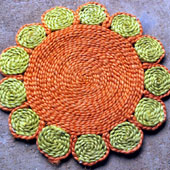Design Resource
Banana Stem
The Art of Crafting Banana Plantation
by
Banana Stem-Making Process
Process of making Banana craft:
The banana fibre is extracted from the banana stem.The products made from banana fibre and stem are smooth, delicate and has a good finish.The banana stem is cut, and the juice is extracted and flattened to make the stem flat for weaving. For flexibility, the banana stem is partially dried in sunlight for 2-3 days depending on the climatic conditions.The inside of the outer layer is used for weaving. It is dyed depending on the requirement.
Process of making Cushion:
The process of making bags and cushions are the same. For cushion making, only banana stem and Kora grass twines are used. However, for making bags fibres from sisal, banana and Kora grass of different colours are used to obtain various designs and patterns. These cushions are popular in Bangalore, Chennai and Delhi.
• The cylindrical frame made of mild steel is used to make a cushion.
• The cushion is made in two halves – upper case and lower case.
• The base of the cushion is made with one metal frame.
• The sides of the frame are covered with a plastic sheet for stiffness and support.
• To begin with the weaving process, a set of ten Kora grass twines is gathered and on
banana stem is used to tie the ten Kora grass twines.
• The ends of the grass are knotted to the upper portion of the frame giving the base support.
• The weaving of the banana stem begins from the base of the cushion.
• The banana fibre is interwoven and simultaneously more grass twines are added to the frame to avoid gaps in the frame.
• The frame is removed by removing the knots.
• The case is stuffed with waste coir and banana stems.
• The knots are removed and the twine is used to join the upper and lower cases.
• The cushion is stitched by passing the needle back and forth, thus interlocking the two halves of the cushion.
• After the joining, the extra twines are cut.
Value addition to the final product happens through polishing, decorating the outer surface.













